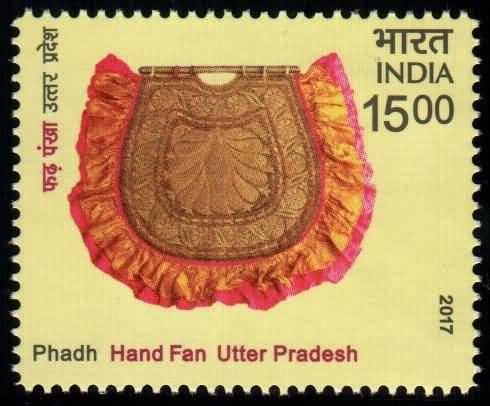Phadh Hand Fan, Uttar Pradesh

Technical Data
| Date of Issue | December 30, 2017 |
|---|---|
| Denomination | Rs.15 |
| Quantity | 100,000 |
| Perforation | 13 |
| Printer | India Security Press, Nashik |
| Printing Process | Wet Offset |
| Watermark | No Watermark |
| Colors | Multicolor |
| Credit (Designed By) | Ms. Nenu Gupta Shri. jatin Das |
| Catalog Codes |
Michel IN 3311 Yvert et Tellier IN 3002 Stanley Gibbons IN 3437 |
| Themes | Crafts |
Phadh Hand Fan – The Royal Breeze of Uttar Pradesh
Introduction
The Phadh Hand Fan from Uttar Pradesh is a magnificent representation of India’s regal craftsmanship and artistic finesse. Traditionally used in royal courts and noble assemblies, this ancient fan embodies luxury, tradition, and cultural pride. With its exquisite fabric, rich embellishments, and elegant form, the Phadh Hand Fan reflects the grandeur of India’s historical past and the fine artistry of its craftsmen.
Historical Background
The origin of the Phadh Hand Fan dates back to the times of Indian royalty and aristocracy. It was once a symbol of prestige and status, used to fan kings, queens, and courtiers during ceremonial gatherings. These fans were often seen in royal courts of North India, especially in Uttar Pradesh, where the art of creating ornamental hand fans flourished under royal patronage.
The word “Phadh” itself signifies fine fabric and festive adornment, symbolizing celebration, devotion, and artistry. Over time, this fan became an integral part of temple rituals and noble households, admired for both its utility and beauty.
Design and Craftsmanship
The Phadh Hand Fan is distinguished by its luxurious materials and intricate detailing. Crafted with silken zari, satin, and silk frills, it stands out as a testament to India’s traditional textile excellence.
Key features include:
- Rich silken fabric with zari (metallic thread) embroidery
- Satin and silk frills, adding a graceful flair
- Elegant golden borders and motifs, symbolizing prosperity
- Handcrafted precision, showcasing the artisan’s meticulous skill
Each fan is designed not merely as a functional object but as a work of art, blending elegance with cultural symbolism. The Phadh Hand Fan’s shimmering appearance and ornate texture make it suitable for religious ceremonies, cultural performances, and royal processions.
Cultural Significance
The Phadh Hand Fan represents the artistry of traditional India — a bridge between royal luxury and devotional simplicity. It was used to fan congregations of royalty and nobles, symbolizing respect and reverence. In temples, similar fans were used to fan deities during rituals, reflecting the belief that comfort and honor should be offered to the divine just as to royalty.
The creation of these fans continues to support local artisans in Uttar Pradesh, many of whom are women skilled in textile crafts and embroidery. Through their work, they preserve the region’s rich heritage of weaving and embellishment, passing down the tradition from one generation to another.
Commemorative Postage Stamp
To honor India’s traditional craft heritage, the Department of Posts issued a commemorative postage stamp featuring the Phadh Hand Fan of Uttar Pradesh as part of the Indian Hand Fans series.
The stamp beautifully captures the splendor of the fan — its silk texture, ornate zari design, and royal allure. It stands as a tribute to the artisans who have kept alive this delicate art form, celebrating their craftsmanship and cultural contribution to India’s artistic legacy.
A Legacy of Elegance and Heritage
The Phadh Hand Fan is more than a historical artifact — it is a living reminder of India’s royal traditions, fine artistry, and devotion to beauty. Its intricate design and luxurious fabric tell tales of a bygone era where every object, no matter how simple in purpose, was crafted with care, reverence, and artistic vision.
Today, preserved through philately and craftsmanship, the Phadh Hand Fan continues to breathe the spirit of India’s heritage, carrying with it the gentle breeze of history, elegance, and timeless tradition.
